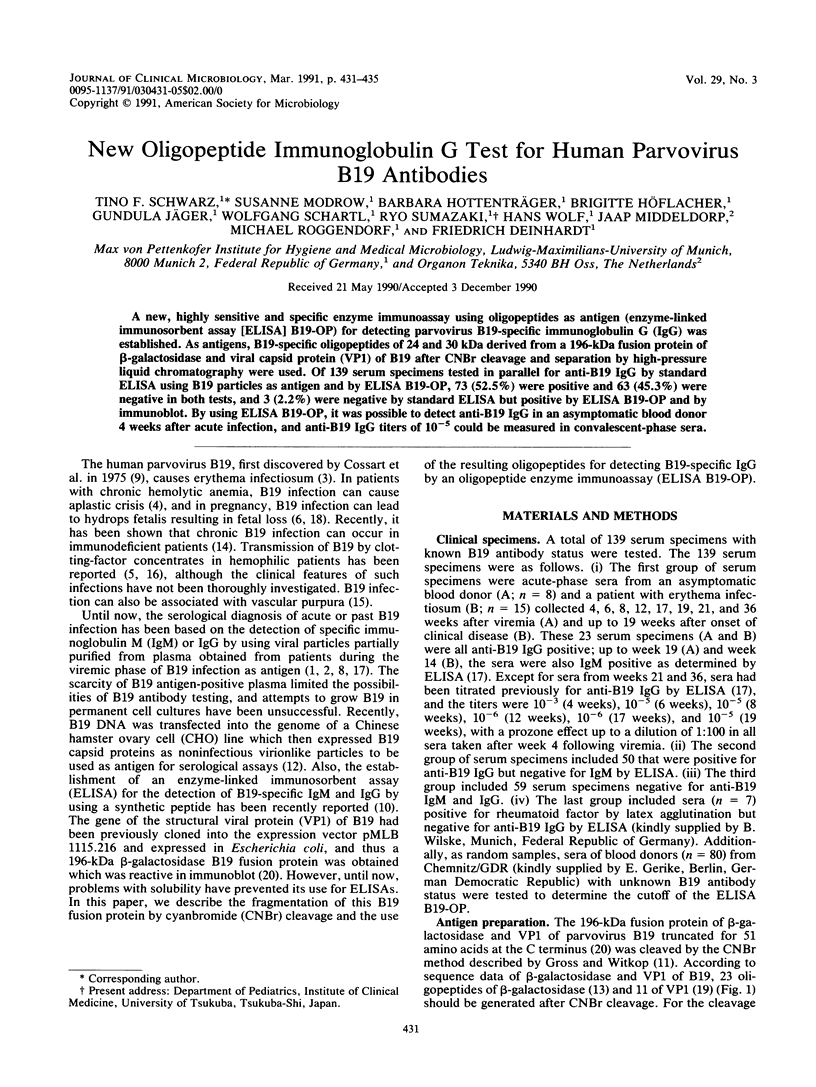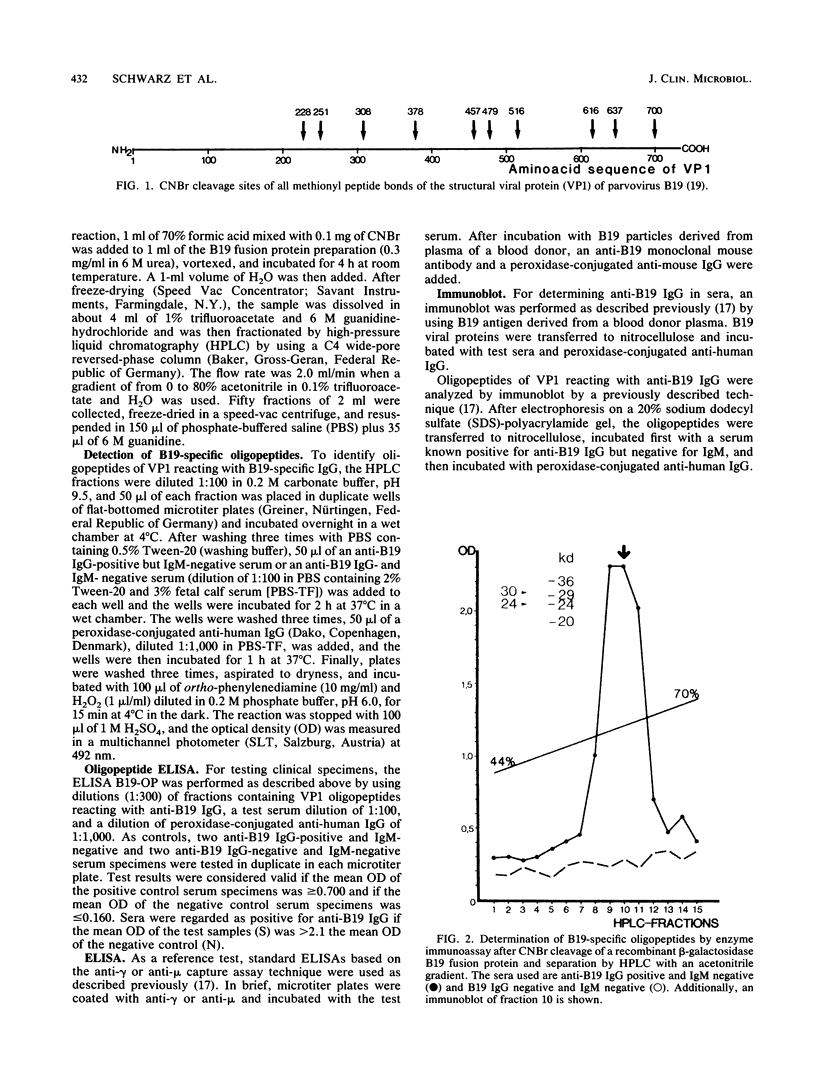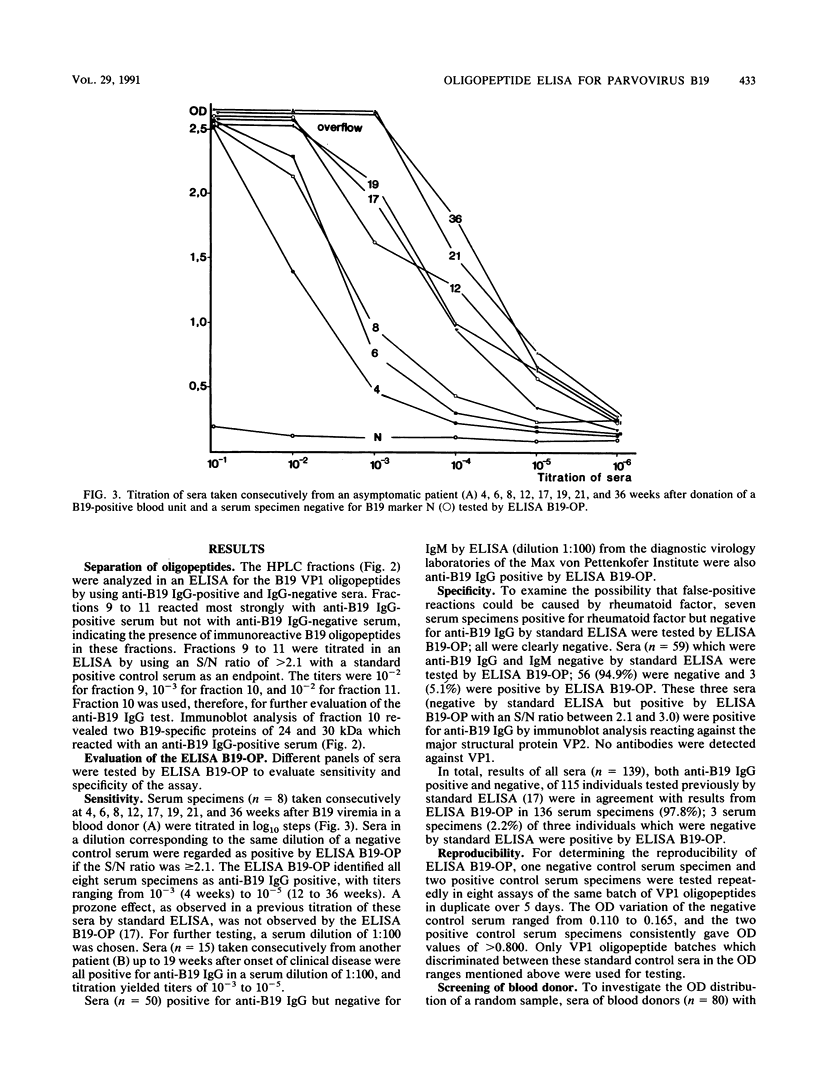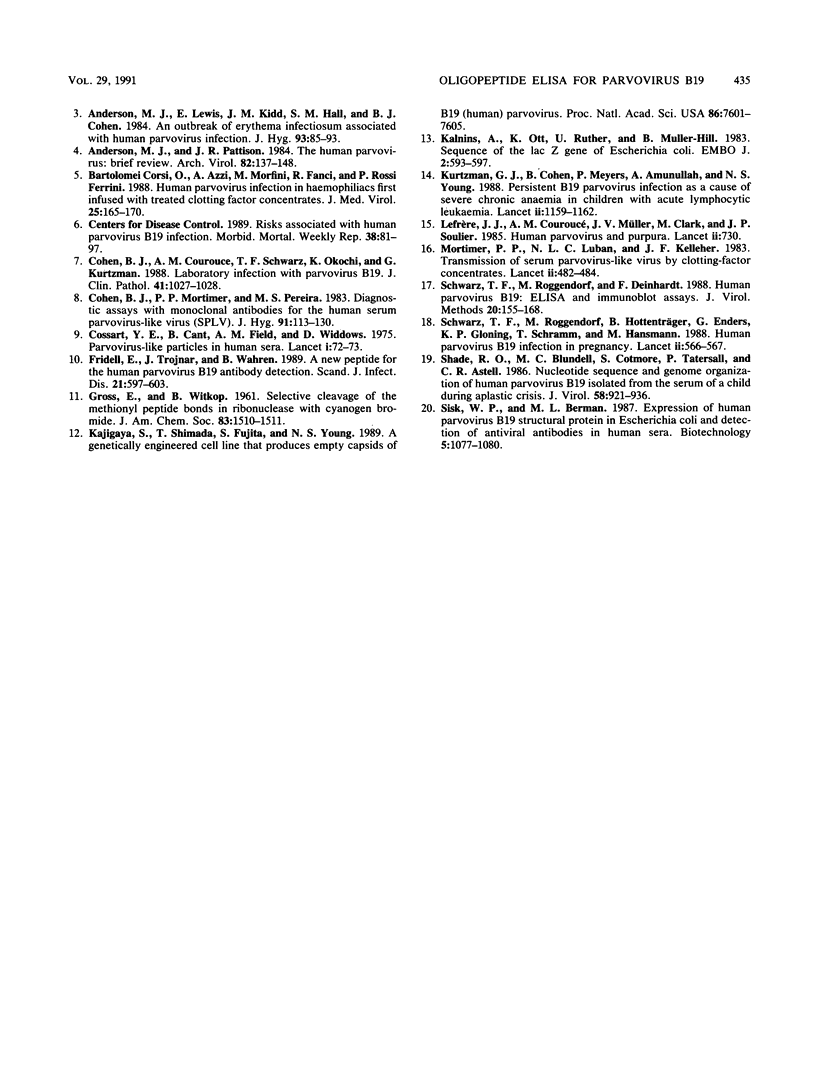Abstract
A new, highly sensitive and specific enzyme immunoassay using oligopeptides as antigen (enzyme-linked immunosorbent assay [ELISA] B19-OP) for detecting parvovirus B19-specific immunoglobulin G (IgG) was established. As antigens, B19-specific oligopeptides of 24 and 30 kDa derived from a 196-kDa fusion protein of beta-galactosidase and viral capsid protein (VPI) of B19 after CNBr cleavage and separation by high-pressure liquid chromatography were used. Of 139 serum specimens tested in parallel for anti-B19 IgG by standard ELISA using B19 particles as antigen and by ELISA B19-OP, 73 (52.5%) were positive and 63 (45.3%) were negative in both tests, and 3 (2.2%) were negative by standard ELISA but positive by ELISA B19-OP and by immunoblot. By using ELISA B19-OP, it was possible to detect anti-B19 IgG in an asymptomatic blood donor 4 weeks after acute infection, and anti-B19 IgG titers of 10(-5) could be measured in convalescent-phase sera.
Full text
PDF




Images in this article
Selected References
These references are in PubMed. This may not be the complete list of references from this article.
- Anderson L. J., Tsou C., Parker R. A., Chorba T. L., Wulff H., Tattersall P., Mortimer P. P. Detection of antibodies and antigens of human parvovirus B19 by enzyme-linked immunosorbent assay. J Clin Microbiol. 1986 Oct;24(4):522–526. doi: 10.1128/jcm.24.4.522-526.1986. [DOI] [PMC free article] [PubMed] [Google Scholar]
- Anderson M. J., Davis L. R., Jones S. E., Pattison J. R., Serjeant G. R. The development and use of an antibody capture radioimmunoassay for specific IgM to a human parvovirus-like agent. J Hyg (Lond) 1982 Apr;88(2):309–324. doi: 10.1017/s0022172400070169. [DOI] [PMC free article] [PubMed] [Google Scholar]
- Anderson M. J., Lewis E., Kidd I. M., Hall S. M., Cohen B. J. An outbreak of erythema infectiosum associated with human parvovirus infection. J Hyg (Lond) 1984 Aug;93(1):85–93. doi: 10.1017/s0022172400060964. [DOI] [PMC free article] [PubMed] [Google Scholar]
- Anderson M. J., Pattison J. R. The human parvovirus. Brief review. Arch Virol. 1984;82(3-4):137–148. doi: 10.1007/BF01311158. [DOI] [PubMed] [Google Scholar]
- Bartolomei Corsi O., Azzi A., Morfini M., Fanci R., Rossi Ferrini P. Human parvovirus infection in haemophiliacs first infused with treated clotting factor concentrates. J Med Virol. 1988 Jun;25(2):165–170. doi: 10.1002/jmv.1890250206. [DOI] [PubMed] [Google Scholar]
- Cohen B. J., Couroucé A. M., Schwarz T. F., Okochi K., Kurtzman G. J. Laboratory infection with parvovirus B19. J Clin Pathol. 1988 Sep;41(9):1027–1028. doi: 10.1136/jcp.41.9.1027-b. [DOI] [PMC free article] [PubMed] [Google Scholar]
- Cohen B. J., Mortimer P. P., Pereira M. S. Diagnostic assays with monoclonal antibodies for the human serum parvovirus-like virus (SPLV). J Hyg (Lond) 1983 Aug;91(1):113–130. doi: 10.1017/s0022172400060095. [DOI] [PMC free article] [PubMed] [Google Scholar]
- Cossart Y. E., Field A. M., Cant B., Widdows D. Parvovirus-like particles in human sera. Lancet. 1975 Jan 11;1(7898):72–73. doi: 10.1016/s0140-6736(75)91074-0. [DOI] [PubMed] [Google Scholar]
- Fridell E., Trojnar J., Wahren B. A new peptide for human parvovirus B19 antibody detection. Scand J Infect Dis. 1989;21(6):597–603. doi: 10.3109/00365548909021686. [DOI] [PubMed] [Google Scholar]
- Kajigaya S., Shimada T., Fujita S., Young N. S. A genetically engineered cell line that produces empty capsids of B19 (human) parvovirus. Proc Natl Acad Sci U S A. 1989 Oct;86(19):7601–7605. doi: 10.1073/pnas.86.19.7601. [DOI] [PMC free article] [PubMed] [Google Scholar]
- Kalnins A., Otto K., Rüther U., Müller-Hill B. Sequence of the lacZ gene of Escherichia coli. EMBO J. 1983;2(4):593–597. doi: 10.1002/j.1460-2075.1983.tb01468.x. [DOI] [PMC free article] [PubMed] [Google Scholar]
- Kurtzman G. J., Cohen B., Meyers P., Amunullah A., Young N. S. Persistent B19 parvovirus infection as a cause of severe chronic anaemia in children with acute lymphocytic leukaemia. Lancet. 1988 Nov 19;2(8621):1159–1162. doi: 10.1016/s0140-6736(88)90233-4. [DOI] [PubMed] [Google Scholar]
- Mortimer P. P., Luban N. L., Kelleher J. F., Cohen B. J. Transmission of serum parvovirus-like virus by clotting-factor concentrates. Lancet. 1983 Aug 27;2(8348):482–484. doi: 10.1016/s0140-6736(83)90512-3. [DOI] [PubMed] [Google Scholar]
- Schwarz T. F., Roggendorf M., Deinhardt F. Human parvovirus B19: ELISA and immunoblot assays. J Virol Methods. 1988 Jun;20(2):155–168. doi: 10.1016/0166-0934(88)90149-8. [DOI] [PubMed] [Google Scholar]
- Schwarz T. F., Roggendorf M., Hottenträger B., Deinhardt F., Enders G., Gloning K. P., Schramm T., Hansmann M. Human parvovirus B19 infection in pregnancy. Lancet. 1988 Sep 3;2(8610):566–567. doi: 10.1016/s0140-6736(88)92684-0. [DOI] [PubMed] [Google Scholar]
- Shade R. O., Blundell M. C., Cotmore S. F., Tattersall P., Astell C. R. Nucleotide sequence and genome organization of human parvovirus B19 isolated from the serum of a child during aplastic crisis. J Virol. 1986 Jun;58(3):921–936. doi: 10.1128/jvi.58.3.921-936.1986. [DOI] [PMC free article] [PubMed] [Google Scholar]



